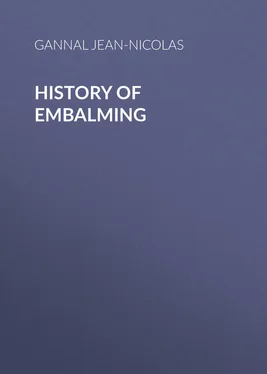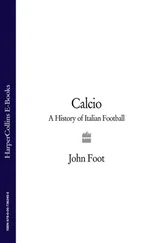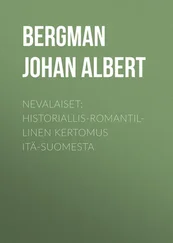Jean-Nicolas Gannal - History of Embalming
Здесь есть возможность читать онлайн «Jean-Nicolas Gannal - History of Embalming» — ознакомительный отрывок электронной книги совершенно бесплатно, а после прочтения отрывка купить полную версию. В некоторых случаях можно слушать аудио, скачать через торрент в формате fb2 и присутствует краткое содержание. Жанр: foreign_antique, foreign_prose, на английском языке. Описание произведения, (предисловие) а так же отзывы посетителей доступны на портале библиотеки ЛибКат.
- Название:History of Embalming
- Автор:
- Жанр:
- Год:неизвестен
- ISBN:нет данных
- Рейтинг книги:5 / 5. Голосов: 1
-
Избранное:Добавить в избранное
- Отзывы:
-
Ваша оценка:
- 100
- 1
- 2
- 3
- 4
- 5
History of Embalming: краткое содержание, описание и аннотация
Предлагаем к чтению аннотацию, описание, краткое содержание или предисловие (зависит от того, что написал сам автор книги «History of Embalming»). Если вы не нашли необходимую информацию о книге — напишите в комментариях, мы постараемся отыскать её.
History of Embalming — читать онлайн ознакомительный отрывок
Ниже представлен текст книги, разбитый по страницам. Система сохранения места последней прочитанной страницы, позволяет с удобством читать онлайн бесплатно книгу «History of Embalming», без необходимости каждый раз заново искать на чём Вы остановились. Поставьте закладку, и сможете в любой момент перейти на страницу, на которой закончили чтение.
Интервал:
Закладка:
I have considered it my duty to give here the details of the composition of the liquids employed, either as baths or injections, by the physician and naturalist; the interest of science imposing on me this obligation. But, as regards embalming, the same motive does not exist; I have consequently abstained from giving in totality the means employed in this operation, reserving to myself the care of this process on the request of families or physicians. 1 1 This paragraph, evidently empyrical in its bearing, is derogatory to Gannal as a man of science. We further believe that the pretended secret of his manipulations is of little consequence to the success of the operation: it is generally understood that to the fluid acetate of alumine (produced by the chemical action induced by the mixture of the solutions of acetate of lead and alum,) to be injected, a little arsenic is added, to prevent the formation of the byssus, and attacks of insects, also some carmine, to give to the subject a healthy colour. — Tr.
It was not until after many unsuccessful efforts that I succeeded in discovering a method capable of insuring the indefinite preservation of bodies deposited in the earth. A thousand unexpected difficulties arose in my path; and to cite only one, at the end of eight or nine months of preservation, a vegetable production, known to botanists under the name of byssus, for a long time embarrassed me; I tried numerous means, before discovering one capable of suppressing this formation.
The perfection to which I have brought the art of embalming, leaves little to desire. So convinced am I at length of the efficacy of the processes which I employ, that I shall be always ready, at the request of the authorities or of families, to exhume those bodies which I have already embalmed in great numbers, at any expressed period of time.
INTRODUCTION
The Egyptians embalmed their dead, and the processes which they employed were sufficiently perfect to secure them an indefinite preservation. This is a fact of which the pyramids, the caverns, and all the sepultures of Egypt offer us irrefragible proofs. But what were the causes and the origin of this custom? We have in answer to this question only hypothesis and conjecture. In the absence of valid documents, each one explains according to the bias of his mind, or the nature of his studies, a usage, the origin of which is lost in the night of time. One of the ancients informs us that the Egyptians took so much pains for the preservation of the body, believing that the soul inhabited it so long as it subsisted. Cassien, on the other hand, assures us that they invented this method because they were unable to bury their dead during the period of inundation. Herodotus, in his third book, observes, that embalming had for its object the securing of bodies from the voracity of animals; they did not bury them , says he, for fear they would be eaten by worms, and they did not burn them, because they considered fire like a wild beast that devours everything it can seize upon . Filial piety and respect for the dead, according to Diodorus Sicculus, were the sentiments which inspired the Egyptians with the idea of embalming the dead bodies. De Maillet, in his tenth letter upon Egypt, refers only to a religious motive the origin of embalming: “The priests and sages of Egypt taught their fellow citizens that, after a certain number of ages, which they made to amount to thirty or forty thousand years, and at which they fixed the epoch of the great revolution when the earth would return to the point at which it commenced its existence, their souls would return to the same bodies which they formerly inhabited. But, in order to arrive, after death, to this wished for resurrection, two things were absolutely necessary; first, that the bodies should be absolutely carefully preserved from corruption, in order that the souls might re-inhabit them; secondly, that the penance submitted to during this long period of years, that the numerous sacrifices founded by the dead, or those offered to their manes by their relations or their friends, should expiate the crimes they had committed during the time of their first habitation on earth. With these conditions exactly observed, these souls, separated from their bodies, should be permitted to re-enter at the arrival of this grand revolution which they anticipated – remember all that had passed during their first sojourn, and become immortal like themselves. They had further the privilege of communicating this same happiness to the animals which they had cherished, provided that their bodies inclosed in the same tomb with themselves, were equally well preserved. It is in virtue of this belief that so many birds, cats, and other animals are found embalmed with almost the same care as the human bodies with which they have been deposited. Such was the idea of perfect happiness which they hoped to enjoy in this new life. In expectation of this resurrection, the souls inhabited the airs nearest the dwellings where reposed the bodies they had animated. But superstition alone, it could scarcely be believed, would induce men to save from destruction the mortal spoils of individuals whom they had loved whilst living. I much prefer looking for the source of this usage in the sentiment which survives a cherished object snatched from affection by the hand of death. Since death levels all distinctions – respecting neither love nor friendship, – since the dearest and most sacred ties are relentlessly broken asunder, it is the natural attribute of affection, to seek to avoid in some degree, a painful separation, by preserving the remains of those they love and by whom they were beloved. Love, tenderness, and friendship, do not terminate with the objects which gave them birth – they survive and follow them even beyond the tomb.” – ( Bory de Saint Vincent, Essay on the Fortunate Islands. – Embalming of the Guanches. ) The same author adds: “The custom of preserving their dead, which was only national among the Egyptians and Guanches, that is to say, with men the least instructed, and a nation the most learned, is, as we have said above, proof of a profound sensibility among nations with whom it is general. Without doubt, an enlightened policy would contribute much to introduce, extend, and confirm the practice. It proves an intelligent government, one full of solicitude for the happiness of its subjects.”
The opinion of Volney, revived and adopted by Pariset, in his memoir on the causes of the plague, is closely allied to the preceding. “In a numerous population, under a burning climate, and a soil profoundly drenched during many months of the year, the rapid putrefaction of bodies is a leaven for plague and disease. Stricken by these murderous pests, Egypt, at an early day, struggled to obviate them; hence have arisen, on the one hand, the custom of burying their dead at a distance from their habitations; and on the other, an art so ingenious and simple, to prevent putrefaction by embalming: a secondary precaution, more important and more efficacious, with which the primary could not dispense, and which, exacting attempts, trials, and experiments, could only be obtained as a last result – an art by no means expensive, of a simplicity and facility of execution, which rendered its immediate application popular, general, and, perhaps, uniform for all dead bodies. Research and luxury followed at a later period.” The sentiments to which the authors above cited attribute the origin of embalming among the Egyptians exist in every man, viewed either as a social or isolated being. One individual may be induced to embalm the bodies of his relatives or friends by motives of superstition; another from egotism or personal interest; a third from motives of salubrity or common interest; another, in fine, is impelled by an instinctive affection to perform the sacred duty of preserving the remains of those who were dear to him. But none of these motives possess a character of generality and perpetuity, which consecrates a usage and renders it popular; it was therefore left to government to interfere and give it the force of law.
Читать дальшеИнтервал:
Закладка:
Похожие книги на «History of Embalming»
Представляем Вашему вниманию похожие книги на «History of Embalming» списком для выбора. Мы отобрали схожую по названию и смыслу литературу в надежде предоставить читателям больше вариантов отыскать новые, интересные, ещё непрочитанные произведения.
Обсуждение, отзывы о книге «History of Embalming» и просто собственные мнения читателей. Оставьте ваши комментарии, напишите, что Вы думаете о произведении, его смысле или главных героях. Укажите что конкретно понравилось, а что нет, и почему Вы так считаете.












